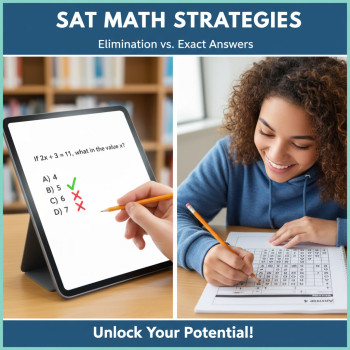Why the Place You Practice Matters More Than You Think
Picture this: you finish a flawless practice Digital SAT at home — calm, headphones on, snacks beside you — and then on test day you sit in a crowded room, unfamiliar device, proctors moving down the aisle. Many students leave a gap between practice conditions and test-day reality, and that gap quietly eats at scores, confidence, and focus. The environment in which you practice isn’t a cosmetic detail; it shapes cognitive load, anxiety, time management, and how well you transfer strategies under pressure.
A quick story
A student I know — let’s call her Maya — practiced exclusively on her laptop with the volume low and a friendly cat at her side. She consistently hit target scores. On test day, however, she felt flustered by the unfamiliar testing app, the bright overhead lights, and the ticking of a nearby clock. Her score dipped. What changed wasn’t Maya’s knowledge; it was the testing environment and her ability to execute under new stimuli. Realistic practice could have closed that gap.
How environment influences the brain during test-taking
Environmental factors do two main things to your brain when you’re taking a timed, adaptive exam like the Digital SAT: they affect cognitive load and emotional arousal.
Cognitive load: fewer distractions mean more working memory
Working memory is the mental space where you hold and manipulate information — it’s crucial for reading passages, performing multi-step math, and following complex reasoning. Every extra stimulus in your environment (a noisy hallway, unfamiliar keyboard, or poor lighting) consumes part of that limited capacity. In short, distracted practice trains your brain to perform with less available working memory. Practicing in a clean, test-like environment helps conserve mental bandwidth for the task itself.
Emotional arousal: the Goldilocks zone
A little anxiety sharpens focus; too much paralyzes it. If practice tests always feel relaxing, your body may not learn to perform under moderate stress. If practice is consistently chaotic, you may become overstressed and underperform. Aim for the Goldilocks zone — slightly elevating arousal so you build resilience, without overwhelming yourself.
Key elements of an effective practice-test environment
Creating a practice environment that mirrors test day helps you build familiarity with materials, pacing, and the feelings that arise under pressure. Here are concrete elements to control:
- Device and software parity — Use the same class of device (Windows, Mac, iPad) and the testing app when possible. The Digital SAT uses a specific digital testing platform; practicing with similar hardware and the Bluebook practice environment reduces surprises.
- Timed conditions — Use full-section and full-test timers. The Digital SAT has a timer and adaptive elements; practice under the same timing rules to calibrate pacing.
- Minimal distractions — Practice in a quiet room with your phone off or in another room. Simulate the small annoyances you might face — background shuffling, ambient hallway noise — occasionally so you learn to refocus.
- Physical setup — Desk height, lighting, chair comfort, and posture matter. Practice in a position similar to the test center to avoid physical discomfort that can break concentration.
- Tools and accommodations — If you use built-in tools like text-to-speech, zoom, or line readers, practice with them active. If you’ve been approved for accommodations, test them in practice so configuration and usage are fluid on test day.
- Scoring and review routine — Score your practice test immediately and then follow an intentional review process. That routine becomes muscle memory for post-test reflection and improvement.
Realism matters: what to simulate and when
There’s realism, and then there’s overdoing it. The point is to make practice feel familiar — not traumatic. Here’s a graduated plan to increase realism as your test date approaches.
Eight weeks out — establish baseline and familiarity
- Use official digital practice tests to map strengths and weaknesses.
- Practice sections rather than full tests to build concepts and strategy.
- Work in short, focused blocks (25–50 minutes) with regular breaks.
Four weeks out — build stamina and timing
- Take at least one full, timed digital practice test each week in a quiet room.
- Bring a basic test-day kit: approved calculator for math, headphones if allowed during practice, water, and a simple snack for breaks while practicing recovery between sessions.
One week out — full simulation
- Replicate test-day start to finish: wake up, follow your morning routine, rehearse arrival time, and sit a full practice test in one sitting.
- Practice with the exact testing interface you’ll use — download and run Bluebook practice tests to confirm comfort with tools like the built-in calculator, line reader, and highlighting.
How specific environmental mismatches lower scores (and how to fix them)
Below are common mismatches students report, what they cost in performance, and simple fixes you can implement today.
| Mismatch | What it costs | Fix |
|---|---|---|
| Different device type (practice on phone, test on laptop) | Slower navigation, missed UI tools, poorer reading/annotation | Practice on the same device family and the test app; borrow an approved device if needed |
| Practicing with unlimited time | Poor pacing; panic when timer appears | Use official timed practice tests; practice pacing by question and passage |
| Ignoring accommodations during practice | Equipment or workflow failures on test day | Enable and use accommodations in practice tests; coordinate with SSD office early |
| Practicing only in comfortable home environment | Difficulty adapting to test-center noise and physical setup | Occasional practice in public spaces or with noise turned on to simulate distractions |
Examples and comparisons: two student profiles
Illustrative comparisons can help make the point practical.
Case A: Liam — the ‘content-only’ student
Liam scored well in class, mastered concepts, and practiced problems untimed on his phone between classes. He avoided full-length tests because they were long and boring. On test day, unfamiliar pacing and UI caused him to rush and skip strategies like re-reading the passage for evidence. His score was below his practice averages.
Case B: Anika — the ‘simulator’ student
Anika built a habit: once a week she took a full-length timed digital practice test in a quiet room using an approved laptop and the testing app. She practiced with the built-in tools (line reader and highlighting), timed her passages, and reviewed errors deeply. She also used one practice session each month in a noisy library to test focus. On test day she felt calm and performed at or above her practice average.
Practical checklist: build your ideal practice session
Here’s a checklist to copy into your study planner. Run through it before every full practice test.
- Device charged and updated; Bluebook or official practice platform installed.
- Quiet space reserved; phone silenced and put away.
- Timer set to mirror real test timing; full-test or full-section as appropriate.
- Physical comforts arranged: water, comfortable chair, natural light if possible.
- Start routine practiced: two deep breaths, read the test instructions once, and begin.
- After the test: score immediately, write three strengths and three targeted improvements before reviewing answer explanations.
How to use practice data to improve — beyond the score
Raw scores are helpful, but the gold is in process metrics: time per question, question types missed, and emotional responses during sections. Tracking these gives you a precise plan for improvement.
Track these metrics
- Average time per question by section and by question type.
- Number of skipped or marked-for-review questions.
- Patterns of error (careless, conceptual, misread, or pacing).
- Anxiety level during each section on a 1–10 scale.
Combine the data into a weekly review. If you consistently run out of time on Math grid-ins, include targeted pacing drills and practice with calculator fluency. If Reading errors are due to miscomprehension under time pressure, practice with shorter, intensive close-reading drills in a timed setting.
How personalized tutoring amplifies realistic practice
Practicing in the right environment helps, but targeted coaching makes those practice hours exponentially more effective. Personalized tutoring — like Sparkl’s 1-on-1 guidance — helps you translate practice-test data into a focused action plan. An experienced tutor can:
- Diagnose the root cause of repeated mistakes (e.g., misreading versus conceptual gaps).
- Create tailored drills that simulate test-day conditions and replicate your weakest moments under pressure.
- Teach stress-management techniques that you can use in practice and on test day.
- Use AI-driven insights (where available) to identify micro-patterns across practice tests and recommend precise practice modules.
When realistic practice meets focused tutoring, you don’t just get better at the questions — you learn to execute knowledge under exam conditions.
Accommodations and the practice environment: special considerations
If you have approved accommodations, practicing with them is non-negotiable. The digital testing platform and College Board guidance allow students to toggle certain built-in accommodations during practice. Use them in practice sessions so you understand how the tools affect pacing, reading, and problem-solving.
- Text-to-speech and screen reader: practice with these features on so you’re comfortable with pacing changes.
- Extended time: mimic extended time blocks and practice stamina. Longer sessions require different energy management strategies.
- Zoom and visual adjustments: practice with the exact zoom levels and color contrasts you’ll use on test day.
Contact your school SSD coordinator early to ensure accommodations are properly approved and practiced before test day.
Mini-experiments to improve your practice environment
Think like a scientist: change one variable at a time and measure the effect. Here are three mini-experiments you can run over three weeks.
- Noise tolerance experiment: Week 1 practice in silence; Week 2 add low-level background noise; Week 3 practice in a library or café. Track error rate and pacing to find your optimal noise level.
- Device experiment: Practice the same section on two different devices to discover which interface gives you faster navigation and fewer mechanical errors.
- Timing experiment: In one week, intentionally shorten the time per section by 10% for practice to build speed. In another week, practice with standard timing but emphasize accuracy to balance speed and precision.
What to do the week before and the morning of the test
In the final week, reduce the novelty in practice and ramp down sheer quantity. Focus on simulation, light review, and physical readiness.
Seven days out
- Two full-length, timed practice tests in test-like conditions (one with normal environment, one with small distractions).
- Light concept review and error analysis from those tests. No last-minute cramming of brand-new material.
- Finalize logistics: test center route, device checklist, and approved accommodations if applicable.
The morning of the test
- Eat a solid breakfast with slow-release carbohydrates and protein (oatmeal, yogurt, or eggs).
- Warm-up: 15–20 minutes of low-pressure practice — a few reading passages or a short math set — to get your brain humming.
- Mindset routine: two minutes of box breathing, a short positive visualization of executing each section calmly, and a reminder of one tactical anchor (e.g., “read question first in math” or “underline main idea in passage”).
Final thoughts: make practice predictable so performance becomes automatic
When you control practice conditions, you turn uncertainty into predictability. That predictability allows your knowledge to flow through practiced routines instead of being blocked by surprise. Practicing under realistic, varied, and data-driven conditions builds fluency with the testing interface, reduces avoidable mistakes, and strengthens psychological resilience.
And remember: practice is most powerful when paired with thoughtful feedback. Whether you analyze mistakes on your own, run mini-experiments, or work with dedicated tutors, the goal is the same — make every practice session closer to the real thing so that on test day, your best performance isn’t a surprise, it’s expected.
If you want tailored practice sessions designed to mimic your exact test-day conditions — including device setup, accommodations, timed pacing, and targeted drills — consider working with an experienced tutor to structure and review your mock tests. Sparkl’s personalized tutoring offers 1-on-1 guidance, tailored study plans, expert tutors, and AI-driven insights to help you make practice count. When practice is realistic and feedback is precise, improvement stops being guesswork and starts being inevitable.
Your next move is simple: pick one element of your practice environment to adjust this week — device, noise level, or timing — and measure the effect. Make changes small, intentional, and repeatable. Over time, these small adjustments compound into a test-day advantage: calm execution, faster recovery from setbacks, and scores that reflect not just what you know, but how well you can show it when it matters most.
Quick takeaway checklist
- Practice on the same device and platform you’ll use for the test.
- Simulate full timing and occasional distractions during practice.
- Use accommodations and tools in practice if they’ll be on test day.
- Track time-per-question, error patterns, and emotional responses.
- Run mini-experiments to optimize your environment.
- Pair realistic practice with targeted feedback — from a coach or a service like Sparkl — to turn practice into higher scores.
Make your practice predictable, resilient, and data-driven — and on test day you’ll discover that the environment stopped being an obstacle and started being an ally.












No Comments
Leave a comment Cancel